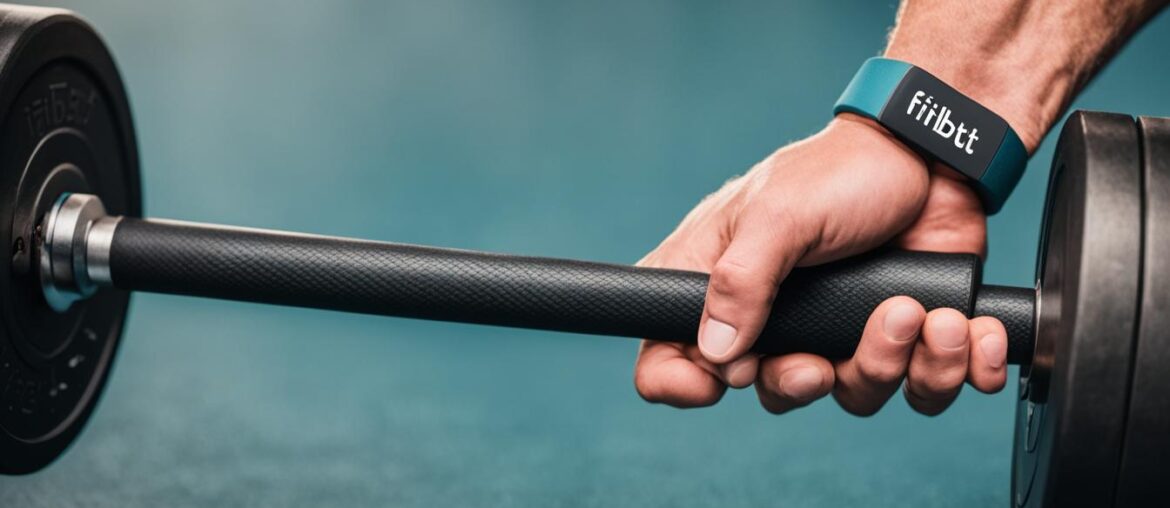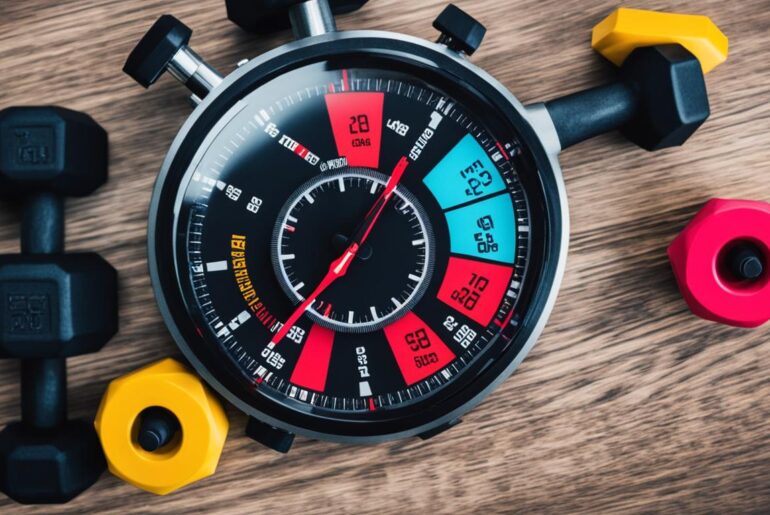Are you wondering how to add strength training to your Fitbit routine (see my post here)? Incorporating strength workouts into your fitness regimen can help improve muscle strength, endurance, and overall fitness levels. Fitbit devices are not just for tracking steps and cardio exercises; they can also be a valuable tool for monitoring and optimizing your strength training sessions.
In this guide, I will walk you through the steps of adding strength training to your Fitbit, from starting a workout to customizing exercise shortcuts. Whether you are new to strength training or looking to enhance your current routine, Fitbit has the features and functionality to support your goals.
Key Takeaways:
- Adding strength training to your Fitbit routine can enhance your overall fitness journey.
- Fitbit devices can track a wide range of exercises, including strength training workouts.
- Utilize the Exercise app on your Fitbit device to choose and start your strength training sessions.
- Customize exercise shortcuts on some Fitbit devices to quickly access your preferred strength workouts.
- Log your exercises and weight to monitor your progress and stay motivated.
How to Start a Workout on Your Fitbit
To begin your strength training workout on your Fitbit device, you’ll need to open the Exercise app and select the activity that aligns with your planned workout. The specific steps may vary slightly depending on your Fitbit device model, so it’s important to refer to the device’s instructions for accurate guidance.
By initiating your workout through the Exercise app, you’ll be able to track your strength training session and monitor your progress. Fitbit devices offer a range of options to choose from, including weightlifting, resistance training, and circuit training, providing you with a versatile platform to tailor your workout to your fitness goals.
Here’s a step-by-step guide to starting a strength training workout on your Fitbit device:
- Open the Exercise app on your Fitbit device.
- Browse through the activity options and select the one that best matches your planned workout, such as “Weightlifting” or “Circuit Training”.
- Follow any additional prompts or instructions provided by your Fitbit device to ensure accurate tracking of your workout.
- Once you’ve selected the activity, your Fitbit device will begin tracking your workout metrics, including duration, heart rate, and calories burned.
- During your strength training session, you can use your Fitbit device to monitor your progress in real time and stay motivated.
Tips for a Successful Strength Training Workout on Fitbit
Here are some additional tips to make the most out of your Fitbit strength training workout:
- Ensure your Fitbit device is securely fastened and positioned correctly on your wrist to accurately track your workout metrics.
- Keep your device charged before starting your workout to avoid interruptions.
- Utilize the exercise shortcuts feature on supported Fitbit devices to easily access your preferred strength training activities.
- Sync your Fitbit device with the Fitbit app after your workout to view detailed metrics and track your progress over time.
Starting a workout on your Fitbit device is a simple process that can help you incorporate strength training into your fitness routine. By following the steps above and utilizing the features of your Fitbit, you can effectively track and monitor your strength training progress, staying motivated on your fitness journey.
Exercises Tracked by Fitbit Devices

Fitbit devices are designed to help you monitor and track a wide range of exercises, allowing you to incorporate strength training into your fitness routine. Whether you prefer weightlifting, biking, running, swimming, or other forms of exercise, your Fitbit device can accurately track your workout progress.
“Fitbit devices provide a seamless way to monitor your strength training exercises and track your progress over time.”
The Exercise app on your Fitbit device offers various options for different activities, ensuring that you can choose the exercise that closely aligns with your strength training routine. By selecting the appropriate activity, your Fitbit will capture important workout metrics such as duration, calories burned, and heart rate.
To give you a better understanding of the exercises you can track with Fitbit, here are some examples:
| Exercise | Description |
|---|---|
| Biking | Outdoor cycling or stationary biking |
| Running | Outdoor or treadmill running |
| Swimming | Pool or open water swimming |
| Weightlifting | Strength training exercises with weights or resistance bands |
| Hiking | Outdoor walking or hiking on different terrains |
| Pilates | A low-impact exercise focusing on core strength and flexibility |
With Fitbit, you can choose from a wide variety of exercises and keep track of your progress as you incorporate strength training into your fitness routine. By monitoring your workouts, you can set goals, measure improvements, and stay motivated throughout your fitness journey.
Why Track Your Strength Training Exercises with Fitbit?
Tracking your strength training exercises with Fitbit has several advantages:
- Progress monitoring: Fitbit allows you to see how you are improving over time, giving you insight into your strength gains and areas for improvement.
- Goal setting: By tracking your strength training, you can set specific goals and work towards achieving them. Fitbit provides you with data to help measure your progress and stay motivated.
- Accurate calorie tracking: Fitbit devices take into account the intensity of your strength training exercises and accurately estimate the calories burned, providing valuable information for your fitness and nutrition goals.
- Heart rate monitoring: Some Fitbit devices offer heart rate monitoring, giving you the ability to track your heart rate during strength training sessions. This data can help you optimize your workouts and ensure you’re in the right heart rate zones for maximum effectiveness.
Whether you are a beginner or an experienced strength trainer, Fitbit devices provide a convenient and effective way to incorporate and track your strength training exercises. With accurate data at your fingertips, you can make informed decisions about your workouts and achieve your fitness goals.
How to Activate Automatic Activity Tracking
Fitbit devices offer a convenient feature that automatically tracks certain activities, even if you forget to select them manually. This makes it easier than ever to ensure that your strength training sessions are accurately recorded and contribute to your overall fitness progress.
To activate automatic activity tracking on your Fitbit, simply follow these steps:
- Open the Fitbit app on your smartphone or tablet.
- Go to the settings menu and select “Tracking & Notifications.”
- Choose “Exercise Shortcuts.”
- Enable the “Automatic Tracking” option.
- Select the types of activities you want Fitbit to automatically track, such as weightlifting, resistance training, or any other strength-focused exercises.
Once you’ve activated automatic activity tracking, your Fitbit device will start capturing data whenever it detects that you’re engaging in the selected activities. This means you won’t have to worry about remembering to manually log your strength training sessions every time.
With the Fitbit app’s automatic activity tracking feature, you can focus on your workout without any distractions and trust that your device is capturing the essential data.
Benefits of Automatic Activity Tracking for Strength Training
Automatic activity tracking for strength training offers several benefits:
- Effortless Recording: Activating this feature eliminates the need for manual input, saving you time and effort.
- Accurate Data: Fitbit devices use advanced sensors to capture your movements accurately, ensuring precise tracking of your strength training sessions.
- Progress Monitoring: With automatic activity tracking, you can easily monitor your progress over time, identifying trends and areas for improvement.
Additionally, by having accurate data at your fingertips, you can set realistic goals, track your achievements, and stay motivated throughout your fitness journey.
Remember, while automatic activity tracking is a convenient feature, it’s always essential to review and verify the recorded data to ensure its accuracy. Manually verify and adjust if necessary to maintain the integrity of your fitness records.
Stay on Track with Automatic Activity Tracking
“Automatic activity tracking on Fitbit devices takes the hassle out of logging your strength training sessions. With accurate and effortless recording, you can focus on maximizing your workout without worrying about missing valuable data.”
Including strength training in your Fitbit routine offers numerous benefits for your overall fitness. With the added convenience of automatic activity tracking, you can make the most of your strength-focused workouts and ensure that every session counts towards reaching your fitness goals.
| Benefits of Automatic Activity Tracking for Strength Training |
|---|
| Effortless Recording |
| Accurate Data |
| Progress Monitoring |
How to Customize Your Fitbit Exercise Shortcuts

Fitbit allows you to customize the exercise shortcuts on select devices, empowering you to efficiently access your preferred strength training workouts. By adding your most commonly used exercises to the shortcuts list, you can quickly initiate your strength training sessions and maximize your fitness potential.
Customizing exercise shortcuts on your Fitbit device is a straightforward process. Follow the steps below to customize your Fitbit exercise shortcuts:
- Open the Fitbit app on your smartphone or navigate to the Fitbit settings on your device.
- Select the “Exercise Shortcuts” option.
- Choose the exercise you want to add or remove from the shortcuts.
- Save the changes to update your exercise shortcuts.
By personalizing your Fitbit exercise shortcuts, you can optimize your strength training routine and streamline your workout experience. Whether it’s adding popular exercises like squats or bicep curls or removing less frequently used ones, the ability to customize shortcuts allows you to tailor your Fitbit device to your unique fitness goals.
With a few simple taps, you can navigate directly to your preferred strength training workouts, saving time and ensuring a seamless transition into your routine. This customization feature enhances the versatility and usability of your Fitbit device, empowering you to take control of your fitness journey.
“I love how Fitbit allows me to personalize my exercise shortcuts. It’s incredibly convenient to have quick access to my favorite strength training exercises right at my fingertips.” – Sarah, Fitbit user
Fitbit Exercise Shortcuts Table:
| Exercise | Shortcut Key |
|---|---|
| Squats | S1 |
| Push-ups | S2 |
| Deadlifts | S3 |
| Plank | S4 |
| Lunges | S5 |
Use this table as a reference to create your ideal list of Fitbit exercise shortcuts. Customize the shortcut keys according to your preference and the exercises that align with your strength training routine. Feel free to add or modify the table entries to suit your individual fitness needs.
How to Log Previous Exercises
In order to keep track of your fitness progress, it’s important to log your previous strength training sessions on your Fitbit device. Luckily, the Fitbit app offers a simple and convenient way to manually log exercises that may have been missed. Here’s how you can do it:
- Open the Fitbit app on your smartphone.
- Access the Exercise app by tapping on the icon.
- Scroll through the exercise options and select the exercise that you want to log.
- For example, if you recently completed a strength training session focused on squats, select “Squats” from the list of exercises.
- Enter the details of your exercise, such as the duration, intensity, and any additional notes you would like to include.
- If you find it helpful, you can also use the notes section to jot down specific details about your workout that you want to remember, such as the number of sets or the weights used.
- Once you have entered all the necessary information, save the exercise and it will be added to your activity history on your Fitbit device.
By logging your previous strength training exercises, you can have a complete record of your fitness activities and monitor your progress over time. This can provide valuable insights into your training routine and help you stay motivated to achieve your fitness goals.
“Logging previous exercises ensures that you have an accurate record of your strength training sessions. It’s an essential step in tracking your progress and maintaining consistency in your fitness journey.” – Fitness Expert
Example Exercise Log:
| Date | Exercise | Duration | Intensity |
|---|---|---|---|
| 2022-01-05 | Squats | 20 minutes | Moderate |
| 2022-01-08 | Push-ups | 15 minutes | High |
| 2022-01-10 | Lunges | 30 minutes | Moderate |
Logging your previous exercises not only helps you stay organized, but it also allows you to analyze your workout patterns and make adjustments as needed. With a comprehensive exercise log, you can make informed decisions about your strength training routine and track your progress towards your fitness goals.
How to Log Weight on Fitbit
![]()
Along with tracking your exercises, Fitbit also allows you to easily log your weight to keep track of your progress. The process for logging weight may vary depending on the device and platform you are using, but rest assured it is a straightforward process.
If you prefer logging your weight through the Fitbit app, follow these steps:
- Open the Fitbit app on your mobile device.
- Navigate to the “Today” tab.
- Scroll down to the “Log” section.
- Tap on “Weight.”
- Enter your current weight in pounds or kilograms.
- Tap on “Save” to record your weight.
If you prefer logging your weight directly on your Fitbit device, follow these steps:
- Swipe to the left on your Fitbit device until you find the “Today” screen.
- Tap on “Log.”
- Scroll down and tap on “Weight.”
- Enter your current weight using the device’s buttons or touchscreen.
- Press the checkmark or select “Save” to save your weight.
By regularly logging your weight on Fitbit, you can monitor your progress and adjust your fitness goals accordingly. It’s a valuable tool to assess the impact of your strength training workouts and overall fitness journey.
Pro Tip: Stay Consistent
“Tracking your weight consistently and at the same time of day can provide a more accurate picture of your progress over time. Consider logging your weight in the morning after using the bathroom for the most consistent results.”
Conclusion
Adding strength training to your Fitbit routine can revolutionize your fitness journey. The Exercise app, customizable shortcuts, and activity logging features make it easy to integrate strength workouts seamlessly into your Fitbit experience. By embracing strength training with Fitbit, you can unlock a world of benefits that will enhance your overall health and fitness levels.
Utilizing the Exercise app allows you to explore a variety of workout plans for strength training, ensuring that you can find the perfect routine to suit your needs and goals. With access to a wide range of exercises tracked by Fitbit devices, you can diversify your strength training program and target different muscle groups effectively.
Not only does strength training improve muscle strength and endurance, but it also boosts your overall fitness. By incorporating Fitbit into your strength training, you can monitor your progress, track your workouts, and log your weight, creating an integrated approach to fitness that empowers you to achieve your goals.




